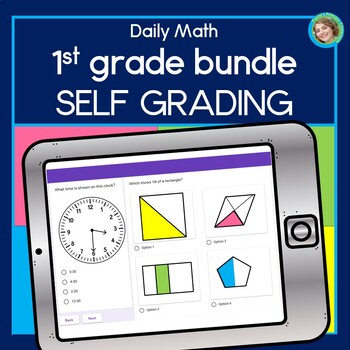1st Grade Daily Math Spiral Review Warm Up Morning Work Digital Year Long Bundle
- Google Drive™ folder

Products in this Bundle (10)
showing 1-5 of 10 products
Bonus
Also included in
- Perfect for morning work or math warm up, this daily math spiral review will have your first graders engaged in learning CCSS math skills! It includes 180 days of NO PREP practice in both printable and self grading digital form so you can easily move between the two formats. The digital version wasPrice $32.00Original Price $63.00Save $31.00
Description
Perfect for digital morning work or math warm up, this self grading daily math spiral review will have your first graders engaged in learning CCSS math skills! It includes 180 days of spiraling practice so your students retain and build on what they learn!
This resource is a digital version of Daily Math for First Grade Year Long Bundle.
It was created with Google Forms™ and is meant to be shared with your students with Google Classroom™. When you download, you will be prompted to copy these assessments into your own Google Drive™ folder, which you can then share with students. Upon completion, you can immediately see student results, including:
- item by item analysis of the students' work,
- individual responses for each student,
- a spreadsheet with all of your students' answers.
With this resource your students will:
- work on addition and subtraction word problems, and will use number lines, 10 frames, number bonds and base 10 blocks to help solve them,
- fill in the missing numbers from number sequences,
- identify 2D and 3D shapes,
- identify addition and subtraction problems as true or false,
- review number pairs that total ten as a strategy in adding 3 numbers,
- identify numbers (up to 120) represented by base 10 blocks, and tell how many groups of hundreds, tens and ones in those numbers,
- use base ten blocks to help solve 2 digit + 2 digit addition problems, including some with regrouping,
- use base ten blocks to subtract multiples of 10 from larger multiples of 10 (ie 26-10),
- sequence 3 items by size,
- from a 2 digit number students will +1, -1, +10 and -10,
- measure with non-standard units,
- interpret graphs with 3 categories, finding most, least, fewest, how many in a category, and the numerical difference between 2 categories,
- read tally marks (up to 65),
- make patterns with 2D and 3D shapes,
- determine if 2 equations are < > =,
- put 3 numbers in order from least to greatest,
- determine the unknown number in addition and subtraction problems,
- tell time to the hour and half hour,
- compare and identify halves and quarters.
To try 9 days of this resource for FREE, try: Daily Math First Grade FREE DIGITAL distance learning for Google Classroom!
Click here to be notified when new resources are released at 50% off!
For more fun learning activities, you may also like:
- Daily Math for First Grade Year Long Bundle,
- First Grade Math Centers Year Long Bundle,
- Hundreds Charts Mystery Pictures, and
- Tangram puzzles.
Thank you for visiting Paula's Primary Classroom!
- Join my email list & get freebies!
- Follow me on FaceBook.
- Follow me on Instagram.
- Follow me on Pinterest.
Have a great day!
♥ Paula






